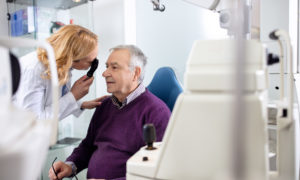By Teresa Narayan, OD

I am an associate at the Georgetown University Hospital ophthalmology clinic in Washington, D.C. Each week, we see about 20 patients with diabetes in various levels of control, and about 5-7 of them have diabetic retinopathy. Diabetics who have long gone undiagnosed are more likely to present at their initial eye exam with some level of diabetic retinopathy.
Diabetes affects all ethnicities, and this is definitely reflected in the patient population I see. However, certain ethnicities, such as African-Americans and Hispanics, are proportionally more plagued by diabetes than others.
For an optometrist, co-managing diabetic patients is a great opportunity. It expands your medical eyecare practice, and it shows all of your patients that your office is capable of providing a wide spectrum of care.
Serving Diabetic Patients: Communications Resources
The AOA Diabetes Eye Report Form can be used as a template for sending reports to MDs.
The National Eye Institute has many useful documents for patient and provider education, including a diabetic tool kit for download that can be used for community outreach.
The American Diabetic Association provides general information for patients. This includes a free program for newly diagnosed patients, with informational packets, recipes, magazines, an online community and text message medication reminders and support.
Co-Management: Growing Opportunity
With more cases of diabetes and more effective means to easily detect it, ODs are seeing more referrals to treat it.
Recently, I’ve been seeing many patients who were referred by their primary care doctor or endocrinologist, but in the past, that wasn’t the case. I think there has been a shift toward more whole body care, and improved patient education has alerted many diabetic patients of the need for regular eye exams. At the same time, there are still plenty of patients who come in for “routine” examinations and their diabetes comes up during history taking. I always take time to educate these patients on the importance of regular dilations.
Tailor Services to Diabetic Needs
The history-taking portion of the exam needs to be tailored for diabetics, and is generally more extensive. I start by asking if the patient checked their blood sugar today. Then I follow up by asking how often they check it. This immediately lets me know how proactive the patient is about managing their disease. Asking about their A1C ratio is also crucial. I’ve found that while many patients can tell you roughly what their blood sugar runs, most do not know their A1C.
It’s important to explain to patients what the A1C is and why it’s an important number that reveals a lot about their condition. I also try to ask probing questions about possible fluctuating vision which can be related to spiking blood sugar. In addition, a thorough run down of their current medications is also vital.
The actual examination can be similar to a non-diabetic exam, but extra attention must be paid to certain tests. The refraction is very important because diabetics often have refractive shifts due to fluctuating blood sugar. As I mentioned, often you will already suspect this based on the history, but a large refractive shift generally should not be prescribed that day, as their refractive error will shift back as their condition stabilizes. The slit lamp exam and dilated fundus examination need to be very thorough to catch any early macular edema, hemorrhages, or neovascularization. If iris neovascularization is seen or suspected, gonioscopy is indicated.
A well controlled diabetic patient with no history of retinopathy may need nothing more than a yearly exam with dilation. Many diabetics have moderate control, with cataracts and maybe mild retinopathy. These patients may need six-month evaluations, along with fundus photos. Other diabetics, with worse control of their disease, may need to be seen every three to four months with fundus photos, macular OCT, and/or gonioscopy as indicated. In general, diabetics can bring in more revenue due to increased office visits and additional testing if medically indicated.
Invest in Needed Instrumentation
In addition to standard exam room equipment, a fundus camera and a OCT that runs a macular software program are standard for providing the best care for diabetic patients. A fundus photograph will make it much easier to observe changes in the patient’s eyes over time. We have just begun looking into replacing our aging fundus camera, and most price quotes are in the $50,000-$70,000 range. If macular edema is seen or suspected, an OCT that runs a macular program (at a cost of $65,000 to $85,000) is the best way to visualize the extent of the edema. Often the edema can be subtle and is not picked up during the fundus examination, but will be clearly visible on the OCT.
If you plan to monitor most of your patients then refer to a retinal specialist as retinopathy or suspected edema appears, a retinal camera may not be needed. But if you plan to specialize in monitoring diabetics in more serious stages of retinopathy, a fundus camera is vital.
Stress Compliance to Diabetes Patients
Most patients have heard that diabetes can affect your eyes, but they don’t know specifically how. For that reason, it is important for the OD to be clear in stating the risk of visual complications, including the potential for blindness. This helps to emphasize the importance of regular dilations. I discuss the possibility of refractive shifts and fluctuating vision, the development of diabetic cataracts and the various forms of diabetic retinopathy. I try to give a general overview and then go into more detail if the patient has a history of previous diabetic complications.
Here is what I might tell a diabetic patient in the exam room:
Regarding refractive shifts…
“As you may know, diabetes can affect your eyes in many ways. If you find that your vision is blurry at certain times of the day or after eating a big meal, this can be a sign that your blood sugar is out of control.”
Regarding cartaracts…
“The spikes and dips in your blood sugar can change the shape of the lens in your eye which can lead to accelerated cloudiness in the form of a cataract. Cataracts will affect your vision, even with glasses, and you may have increased difficulty with glare. Glasses may help your vision, but it still will be limited by the cataract.”
Regarding diabetic retinopathy and the need for regular eye examinations…
“Diabetes can also weaken your blood vessels and cause blood leakage on the inside of your eye. Sometimes, in the early stages, this blood leakage has no symptoms, but if left unchecked, it can cause a significant vision decrease that can be permanent. Therefore, regular eye examinations with dilation are important to closely monitor your eye health.”
Communicate Frequently with Co-Managing MDs
The biggest key to co-management with MDs is communication. Promptly written report forms or letters detailing the patients ocular condition is in the patient’s best interest and lets the MD know that you know what you are doing. There are form templates online available through the AOA (see box), as well as other organizations, but most electronic health record systems will have an automatic letter function. Our EHR can print a tailored letter containing the relevant parts of the examination and can electronically send the letter immediately to the appropriate provider. Initial set up may take a little work, but once set up, features like this make it easy to keep on top of the necessary communication.
I refer the patient back to the primary care doctor or endocrinologist in most cases of a newly diagnosed ocular complication. For example, in the case of a significant refractive shift, I will send the patient back to their MD to evaluate their blood sugar control, and once their levels are stable, they return to have their refraction re-checked, along sometimes with another dilation of their eyes. I also will send a patient back to their MD, and also to a retinal specialist depending on severity, for any newly diagnosed retinopathy.
Have Staff Support Diabetic Patient Management
Many offices have technicians who take general patient histories prior to the doctor seeing the patient. These technicians need to be educated on the types of questions cited earlier that are necessary for a thorough diabetic history. Opticians play an important role because many diabetics have some level of cataracts, and anti-reflective treatment or tinted lenses can help alleviate some of the increased glare that the patient might be experiencing. Aside from retinal injections, there aren’t any ocular medications for diabetic ocular complications, so while eyecare drug company representatives have great resources for staff education, this is one area where the doctor in the practice is probably best suited to educate the support staff.
Related ROB Articles
Diabetes Screener: Identify Diabetics Early and Non-Invasively
Boost Treatment of Diabetic Patients to Grow Practice
Improve Medical Eyecare Treatment Compliance by Tailoring Regimens to Lifestyle
Teresa Narayan, OD, is an associate OD in Georgetown University Hospital ophthalmology clinic, Washington DC. To contact: teresanarayanod@gmail.com

























